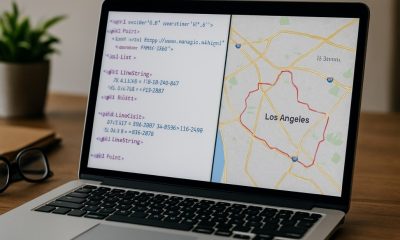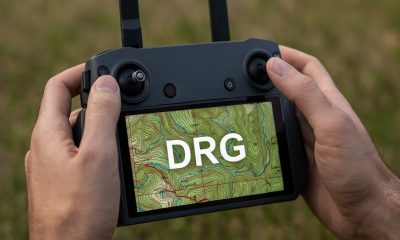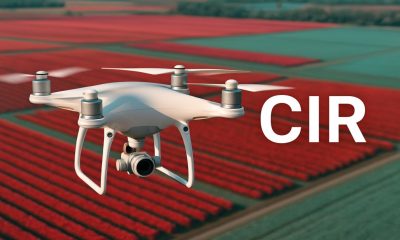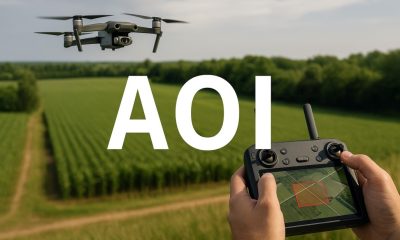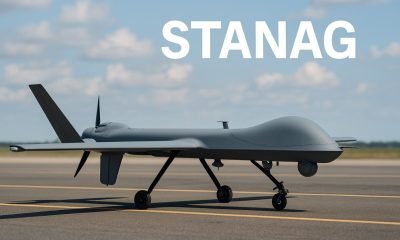- Acronym Guide
- AAM
- ABS
- AC
- ACAS
- ADS-B
- AFAC
- AGL
- AI
- AIM
- ALS
- AM
- AMA
- ANSP
- AOI
- APPI
- AUV
- AUVSI
- ARPAS-UK
- ASTM
- ATC
- BVLOS
- CAA
- CAAC
- CAB
- CASA
- CATT
- CBO
- CBR
- CBRN
- CDMA
- CDR
- CFR
- CIR
- COA
- COMINT
- CORS
- COTP
- COTR
- CPTED
- CV
- C2
- DAA
- DEM
- DFI
- DFS
- DGCA
- DHS
- DOD
- DPA
- DPEs
- DRG
- DRO
- DSM
- DSMX
- DSP
- DSSS
- DTM
- EASA
- EFT
- EO
- EOD
- EO/IR
- ELINT
- EMI
- ESC
- EVLOS
- eVTOLs
- FAA
- FCC
- FCS
- FHSS
- FICCI
- FLIR
- FOB
- FOV
- FPS
- FPV
- GBDAA
- GCP
- GCS
- GDPR
- GML
- GNSS
- GPS
- GSD
- GVC
- HDR
- HOGE
- IACRA
- ICAO
- ICS
- IMU
- INS
- IR
- ISA
- ISR
- ITU
- JARUS
- LAAMS
- LAANC
- LAATM
- LAI
- LBA
- LIDAR
- LOS
- LSALT
- MAC
- MAVLink
- MLIT
- MMS
- MSL
- MTOM
- NDAA
- NCSL
- NFZ
- NIST
- NMEA
- NOTAM
- NPA
- NPRM
- NTIA
- OBIA
- OEM
- OFDM
- OOP
- PASM
- PAV
- PCV
- PdM
- PEC
- PIC
- PID
- PIPL
- PLD
- PM
- PN
- PPK
- PPS
- PSM
- PWM
- UAM
- UAOP
- UAS
- UASTM
- UAV
- UCAVs
- UHD
- UHF
- USV
- UTM
- RAIM
- RCC
- RCS
- RFI
- ReOC
- RePL
- RMS
- ROI
- RPAS
- RPC
- RTH
- RTK
- SaR
- SAR
- SARP
- SBAS
- S.Bus
- SBIR
- SEDENA
- SfM
- SFOC
- SIGINT
- SLAM
- SMS
- SORA
- STANAG
- STTR
- sUAS
- TCAS
- TCCA
- TFR
- TIN
- TOF
- TP
- TPS
- TSA
- VHF
- VLOS
- VTOL
Drone Acronyms
What is FAA (Federal Aviation Administration) & How Does it Work?
By
Jacob StonerTable Of Contents

Definition
FAA stands for Federal Aviation Administration. It is a governmental body of the United States Department of Transportation that regulates and oversees all aspects of civil aviation in the U.S. This includes the certification and regulation of aircraft, air traffic management, and the enforcement of safety standards.
Relevance to the Industry
The FAA plays a crucial role in the integration and regulation of drones within the U.S. airspace. By providing clear guidelines and regulations, the FAA ensures that drone operations are conducted safely and responsibly. Compliance with FAA regulations is mandatory for all commercial and recreational drone operators in the U.S.
How Does the Federal Aviation Administration (FAA) Work?
The Federal Aviation Administration (FAA) is a governmental body in the United States responsible for regulating and overseeing all aspects of civil aviation. The FAA’s mission is to ensure the safety and efficiency of the national airspace system. Here’s a detailed explanation of how the FAA works:
1. Overview and Mission
- Mission Statement: The FAA’s primary mission is to provide the safest, most efficient aerospace system in the world.
- Scope of Authority: The FAA regulates civil aviation, including aircraft operations, air traffic control, certification of pilots and aircraft, and the management of airspace.
2. Key Functions and Responsibilities
- Regulation and Oversight: The FAA develops and enforces regulations and standards for all aspects of aviation, including aircraft manufacturing, maintenance, operation, and safety.
- Air Traffic Control (ATC): The FAA operates a nationwide system of air traffic control facilities that manage the safe and efficient movement of aircraft in U.S. airspace.
- Certification: The FAA certifies aircraft, pilots, airports, and aviation-related businesses to ensure they meet safety standards.
- Research and Development: The FAA conducts research to improve aviation safety, efficiency, and environmental performance. This includes developing new technologies and procedures.
- Environmental Stewardship: The FAA works to minimize the environmental impact of aviation through regulations and initiatives aimed at reducing noise and emissions.
- Enforcement: The FAA has the authority to enforce aviation regulations and take action against individuals or entities that violate them.
3. Regulation and Certification
- Aircraft Certification: The FAA certifies the design, production, and airworthiness of aircraft and aircraft components. This includes issuing Type Certificates (TC) and Supplemental Type Certificates (STC).
- Pilot Certification: The Federal Aviation Administration certifies pilots, ensuring they meet rigorous training and medical standards. Certifications include various levels and types, from private pilot to airline transport pilot.
- Airport Certification: The Federal Aviation Administration certifies airports for public use, ensuring they meet safety and operational standards. This includes inspecting facilities and approving operational procedures.
- Airline and Operator Certification: The FAA certifies airlines and other operators (e.g., charter services) to ensure they meet safety standards and regulations.
4. Air Traffic Control (ATC)
- ATC Facilities: The Federal Aviation Administration operates a network of control towers, terminal radar approach control facilities (TRACONs), and air route traffic control centers (ARTCCs) to manage aircraft movements.
- Separation Standards: ATC provides separation between aircraft to prevent collisions and ensure safe travel. This includes vertical, horizontal, and time-based separation standards.
- Flight Plans: Pilots file flight plans that are reviewed and approved by the FAA to ensure safe and efficient routing through controlled airspace.
- Traffic Flow Management: The Federal Aviation Administration manages the flow of air traffic to avoid congestion and delays, optimizing the use of available airspace.
5. Safety and Enforcement
- Safety Inspections: The Federal Aviation Administration conducts regular inspections of aircraft, operators, maintenance facilities, and training programs to ensure compliance with safety standards.
- Incident Investigation: The Federal Aviation Administration investigates aviation incidents and accidents to determine causes and prevent future occurrences. It works closely with the National Transportation Safety Board (NTSB) in these investigations.
- Regulatory Enforcement: The Federal Aviation Administration has the authority to take enforcement actions, such as fines, certificate suspensions, and legal actions, against individuals or organizations that violate aviation regulations.
6. Research and Development
- Innovation and Technology: The Federal Aviation Administration invests in research and development to enhance aviation safety, efficiency, and environmental performance. This includes advancements in air traffic management, navigation systems, and aircraft technology.
- NextGen: The FAA’s Next Generation Air Transportation System (NextGen) is a comprehensive modernization initiative aimed at transforming the national airspace system through advanced technology and procedures.
7. Environmental Stewardship
- Noise Reduction: The FAA works to mitigate aircraft noise through regulations, community engagement, and technology advancements.
- Emissions Reduction: The FAA collaborates with industry and international partners to reduce aviation emissions and promote sustainable aviation fuels.
8. Public and Industry Engagement
- Advisory Committees: The Federal Aviation Administration engages with various advisory committees, including the Aviation Rulemaking Advisory Committee (ARAC) and the NextGen Advisory Committee, to gather input from industry stakeholders.
- Public Communication: The Federal Aviation Administration communicates with the public through various channels, including press releases, public meetings, and social media, to provide information about aviation safety and regulations.
9. International Collaboration
- Global Standards: The Federal Aviation Administration collaborates with international aviation authorities and organizations, such as the International Civil Aviation Organization (ICAO), to harmonize global aviation standards and practices.
- Bilateral Agreements: The Federal Aviation Administration enters into bilateral aviation safety agreements with other countries to facilitate mutual recognition of certification and regulatory oversight.
Understanding how the Federal Aviation Administration (FAA) works highlights its critical role in ensuring the safety and efficiency of the national airspace system. Through regulation, certification, air traffic control, research, and international collaboration, the FAA maintains the highest standards of aviation safety and fosters the growth and sustainability of the aviation industry.
Example in Use
“Before conducting commercial drone operations, the company ensured all pilots were certified and drones were registered according to FAA regulations.”
Frequently Asked Questions about FAA (Federal Aviation Administration)
1. What are the key FAA regulations for drone operations?
Answer: Key FAA regulations for drone operations include:
- Registration: All drones weighing over 0.55 pounds must be registered with the FAA.
- Pilot Certification: Commercial drone pilots must obtain a Remote Pilot Certificate by passing the FAA’s Part 107 exam.
- Operational Limitations: Drones must be flown within visual line of sight, not over people or moving vehicles, and below 400 feet AGL (Above Ground Level).
- Airspace Authorization: Operations in controlled airspace require prior authorization from the FAA.
2. How does the FAA ensure the safety of drone operations?
Answer: The FAA ensures the safety of drone operations by:
- Establishing Regulations: Setting rules and guidelines for safe drone operations, including registration, certification, and operational limits.
- Enforcement: Monitoring compliance with regulations and taking enforcement actions against violations.
- Education: Providing resources and information to educate drone operators about safe practices and regulatory requirements.
- Air Traffic Management: Coordinating with air traffic control to integrate drones into the national airspace safely.
3. What is the process for obtaining FAA authorization for drone operations in controlled airspace?
Answer: To obtain FAA authorization for drone operations in controlled airspace, operators must:
- Submit a Request: Use the FAA’s Low Altitude Authorization and Notification Capability (LAANC) system or the FAA DroneZone portal to request airspace authorization.
- Provide Details: Include information about the operation, such as location, altitude, time, and duration.
- Review and Approval: The FAA reviews the request and, if approved, grants authorization to operate in the specified airspace under certain conditions.
For examples of these acronyms visit our Industries page.
As the CEO of Flyeye.io, Jacob Stoner spearheads the company's operations with his extensive expertise in the drone industry. He is a licensed commercial drone operator in Canada, where he frequently conducts drone inspections. Jacob is a highly respected figure within his local drone community, where he indulges his passion for videography during his leisure time. Above all, Jacob's keen interest lies in the potential societal impact of drone technology advancements.


